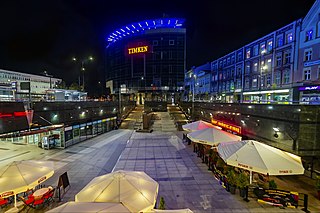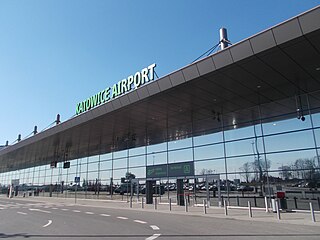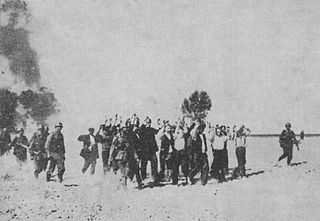
Lesser Poland, often known by its Polish name Małopolska, is a historical region situated in southern and south-eastern Poland. Its capital and largest city is Kraków. Throughout centuries, Lesser Poland developed a separate culture featuring diverse architecture, folk costumes, dances, cuisine, traditions and a rare Lesser Polish dialect. The region is rich in historical landmarks, monuments, castles, natural scenery and UNESCO World Heritage Sites.

Silesian Voivodeship or Silesia Province is a voivodeship, or province, in southern Poland centered on the historic region known as Upper Silesia, with Katowice serving as its capital.

A voivodeship is the highest-level administrative division of Poland, corresponding to a province in many other countries. The term has been in use since the 14th century and is commonly translated into English as "province".

Katowice is the capital city of the Silesian Voivodeship in southern Poland and the central city of the Upper Silesian metropolitan area. It is the 11th most populous city in Poland, while its urban area is the most populous in the country and one of the most populous in the European Union.

Zabrze is an industrial city in Silesia in southern Poland, near Katowice. The west district of the Silesian Metropolis, a metropolis with a population of around 2 million. It is in the Silesian Highlands, on the Bytomka River, a tributary of the Oder.

Sosnowiec is an industrial city county in the Dąbrowa Basin of southern Poland, in the Silesian Voivodeship, which is also part of the Silesian Metropolis municipal association. Located in the eastern part of the Upper Silesian Industrial Region, Sosnowiec is one of the cities of the Katowice urban area, which is a conurbation with the overall population of 2.7 million people; as well as the greater Upper Silesian metropolitan area populated by about 5.3 million people. The population of the city is 191,676 as of December 2022.

Chorzów is a city in the Silesia region of southern Poland, near Katowice. Chorzów is one of the central cities of the Upper Silesian Metropolitan Union – a metropolis with a population of 2 million. It is located in the Silesian Highlands, on the Rawa River.
A voivodeship or voivodate is the area administered by a voivode (governor) in several countries of central and eastern Europe. Voivodeships have existed since medieval times and the area of extent of voivodeship resembles that of a duchy in western medieval states, much as the title of voivode was equivalent to that of a duke. Other roughly equivalent titles and areas in medieval Eastern Europe included ban and banate.

Upper Silesia is the southeastern part of the historical and geographical region of Silesia, located today mostly in Poland, with small parts in the Czech Republic. The area is predominantly known for its heavy industry, mining, and the Silesian language.

Będzin is a city in the Dąbrowa Basin, in southern Poland. It lies in the Silesian Highlands, on the Czarna Przemsza River. Even though part of Silesian Voivodeship, Będzin belongs to historic Lesser Poland, and it is one of the oldest towns of this province. Będzin is regarded as the capital of industrial Dąbrowa Basin.

Ruch Chorzów is a Polish association football club based in Chorzów, Upper Silesia. It is one of the most successful football teams in Poland, having won fourteen league titles, and the Polish Cup thrice. They currently compete in the Polish Ekstraklasa. Ruch's home venue is the Ruch Stadium, with a capacity of 9,300 seats. As it is currently under renovation, Ruch temporarily hosts their games at the Stadion Śląski with a capacity of 55,211 seats. The club is known for its Silesian identity. Ruch Chorzów has also had a very successful female handball team.

Katowice Wojciech Korfanty Airport is an international airport, located in Pyrzowice, 30 km (19 mi) north of Katowice, Poland. The airport has the 4th-biggest annual passenger flow in Poland. Katowice Airport is the biggest Polish airport in terms of leisure traffic. It is also the second biggest airport in the country in terms of cargo traffic.

The Silesian Autonomy Movement, abbreviated as RAŚ, is a movement officially declaring its support for the autonomy of Silesia as part of a unified Europe. The association was founded in January 1990 by Rudolf Kołodziejczyk and is based in the Polish part of Upper Silesia. RAŚ sees the Silesians as a "separate nation" rather than primarily as Poles, Germans or Czechs.

The pacification actions in German-occupied Poland during World War II were one of many punitive measures designed to inflict terror on the civilian population of local villages and towns with the use of military and police force. They were an integral part of the war of aggression against the Polish nation waged by Nazi Germany since September 1, 1939. The projected goal of pacification operations was to prevent and suppress the Polish resistance movement in World War II nevertheless, among the victims were children as young as 1.5 years old, women, fathers attempting to save their families, farmers rushing to rescue livestock from burning buildings, patients, victims already wounded, and hostages of many ethnicities including Poles and Jews.

The World Polonia Games are a multi-sport event held annually for the Polish diaspora (Polonia) and Polish minorities living outside of Poland. Held annually and alternating between summer and winter games each year, the games bring hundreds of participants from multiple countries worldwide, such as Algeria, Argentina, Australia, Austria, Belgium, Brazil, Canada, Chile, China, Denmark, Egypt, Finland, France, Germany, Iran, Israel, Italy, Japan, Kazakhstan, South Korea, Malaysia, Mexico, Morocco, the Netherlands, Norway, Poland, Russia, Saudi Arabia, South Africa, Spain, Sweden, Switzerland, Thailand, Tunisia, Turkey, Ukraine, the United Kingdom and the United States.

The city of Kraków is divided into 18 administrative districts, each with a degree of autonomy within the municipal government. The Polish name for such a district is dzielnica.

In the NUTS codes of Poland (PL), the three levels are:
















